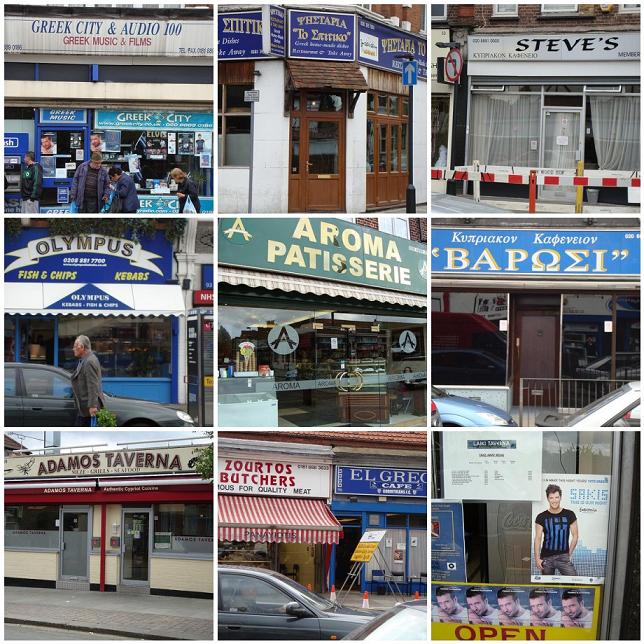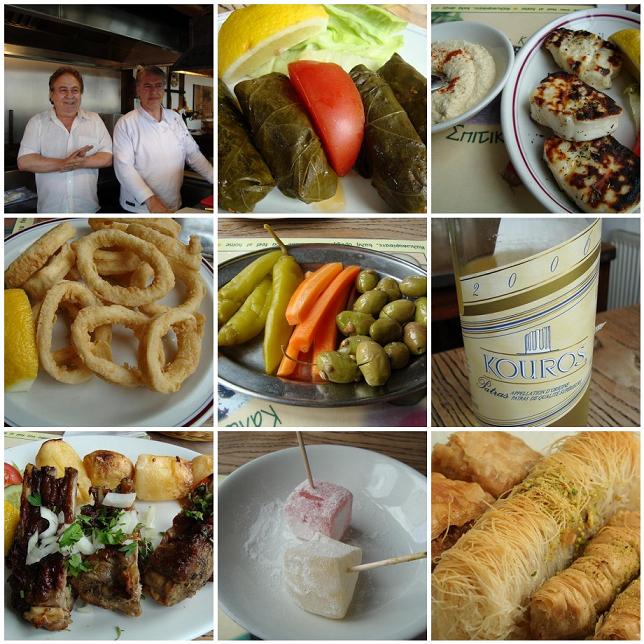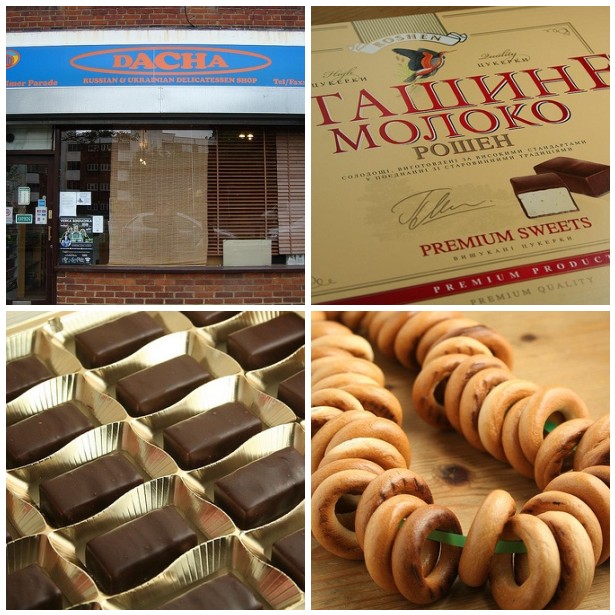Posted By Stephen

A few weeks ago, following a very successful bloggers visit to Tayabb’s, the idea of Eating Eurovision was born. The premise was simple: could 25 food bloggers eat the cuisine of the 25 partaking countries, all within the M25, within 25 hours? This was not to be an exercise in Googling recipes and cooking the dish of your country in the comfort of your own home but an opportunity to investigate the community and converse with the locals.
So, on Thursday night, we trooped en masse to the BBC Television Centre where we sat down to watch the last semi-final and conduct the big draw. After an entertaining (although sometimes painful) couple of hours, the final nine names were announced and we got on with the business of drawing names (ping-pong balls) from a hat (trendy cotton shopping bag). We drew Greece and the Ukraine.
In Greece, we were fairly confident and our research showed us that Palmers Green was were it was at. On arrival, we were lucky enough to meet Sue at the Lefteris Bakery who told us that the bakery had been under current management for 15 years. She doesn’t live in the area anymore, having moved out to Cockfosters but confirmed that there were still a great many Greek families living locally, mostly because there were so many facilities available to them locally (we spotted a bakery, butcher, patisserie, social club and many restaurants, all within a few minutes walk of each other). After purchasing some baklava we asked Sue where she ate with her family, she recommended Spitiko which was just down the road.

On entering Spitiko, we were greeted by Andy and Stellios who, while slightly bemused, were both happy to answer our stream of questions. Stellios has been running Spitiko for nine years but has been living in the area for the last 40, having originally arrived in London to study. He explained that many Greeks have now moved away from the area; some, like Sue, moving further out to Cockfosters and Southgate but many returning to Greece. He was very proud of the restaurant and the food they served which he told us was nothing like the new stream of Greek restaurants that have opened up recently. These, according to Stellios, are all run by Greek wives who are not chefs and believe that making kebabs is all there is to Greek food. His language started to get more colourful at this point but I’ll gloss over that and tell you about the food.

Conscious of the crossover between Greek and Cypriot food, we were keen to make sure we really were eating the cuisine of our Eurovision country. Andy told us that there wasn’t really much difference between the two and that back in Greece, the cuisine was pretty similar all over the country. Not wanting to disagree, we decided on a selection of mezze, followed by one main course to share. We bravely ordered some Greek wine too which was actually fairly drinkable. We started with a familiar selection of hummus, halloumi, calamari and dolmades which was all very fresh and well cooked. The main course of lamb souvla was interesting, spit roasted lamb ribs served with roast potatoes. The meat was tenderand had taken on a wonderful smokiness from the charcoal grill.
After our big fat Greek lunch we were feeling rather sleepy, which threw our Ukrainian exploits off course a little. Conveniently, one of Stephen’s cousins has a Ukrainian girlfriend, Nataliia, who we interrogated briefly. She assured us that the “most common and best” Ukrainian food is golubtsi… more on that later.
We managed to get a bus to East Finchley on the way back from Palmers Green where we visited Dacha, which calls itself a “Russian and Ukrainian Delicatessen Shop”. We wandered in and were greeted in Russian by the lady running the shop. We smiled and nodded and said “hello”, which made her look rather surprised; it was obvious that we were the foreigners in this particular context. We started browsing, without really knowing what we were looking for, but were hoping that it would jump out at us when we found it.
There were quite a variety of foods, including frozen dumplings of various sorts, biscuits, lots of pickles and relishes and other jars, along with some freshly made, refrigerated dishes. After a few minutes of browsing, we were having trouble identifying which were Ukrainian rather than Russian (or Lithuanian or Estonian, which were mentioned on a lot of labels and would have been easier) so clearly we needed to ask the lady for some help. Or so we thought. She replied, saying “I’m sorry, I don’t speak English” in perfect English. If you don’t speak English then you probably get quite practiced at saying that particular phrase, but it can be rather odd to hear it pronounced so well. She did try to help, but we completely failed to to make ourselves understood – no amount of pointing and saying “Ukraine” was met with anything other than shrugs of incomprehension.

Luckily at this point another customer arrived and spoke Russian to the lady running the shop, so we asked her if she spoke English (which she did, thankfully) and asked if she minded translating a few things for us (which she didn’t, thankfully). Having broken through the communication barrier, we were eventually shown to several Ukrainian foods, including chocolates, biscuits on a string, and a couple of the pre-prepared, refrigerated dishes which looked promising. One of which was the golubtsi that we’d been told was the “best” Ukrainian food, so that was a breakthrough at least. Another was a very mayonnaisey olivje salad. We decided to buy some chocolates and biscuits and also ingredients to make up the olivje and golubtsi ourselves. There were a couple of curious bottles of Ukrainian dessert wine on display, but weren’t priced and we didn’t think we particularly needed it anyway, but should at least have taken a picture of them, which we didn’t.
We had planned to visit the Association of Ukrainians in Great Britain (located in Notting Hill) on the way home, but time had been getting away from us and the Greek food and wine was taking its toll, making us nod off on the Tube on the way. Luckily we were awake at the important changing points, so we did eventually make it home. We called the AUGB and asked them a few questions – we were put through to The Librarian who suggested that we come down to The Library and have a look at the books there for information. But we couldn’t fit that in, so not a lot of background history, sorry.

So, back to the food. For both of the dishes, recipes vary from place to place and family to family of course. The general recipe for olivje salad is fairly simple: Take cooked potato, cooked carrot, boiled egg and cooked sausage and chop these up into similarly sized pieces, roughly centimetre cubes. Add some cooked peas, mayonnaise and salt to taste. Mix together. Eat. This is similar to the Russian Salad that is always to be found on the menu in tapas bars; I’ve ordered it several times and always enjoy the first mouthful but after that find the overbearing mayonnaiseyness too much to handle. The olivje in the Russian and Ukrainian Delicatessen Shop had also been heavy on the mayonnaise, so our version probably wasn’t authentic, but I did eat the lot and rather enjoyed it.
Making golubtsi involves making a meat and rice filling, then wrapping this in cabbage leaves and stewing / steaming this in stock or tomato juice. The similarity between this and the dolmades that we’d had for lunch was not lost on us. We mixed pork mince with rice, onion, tomato paste and parsely and then wrapped this mixture in blanched cabbage leaves, cooking them in a mixture of beef stock and tomato puree. The tomato left strange-looking red lines around the golubtsi , but at least our rolling skills were just good enough for them to hold together during cooking. We were completely stuffed by this point, but just tasted a couple – they were nice but needed a bit more seasoning. And probably various accompaniments that Nataliia had told us about, e.g. sour cream, parsley and mixed salad.
We both knew a little about Greek cuisine before we embarked on Eating Eurovision but knew nothing about the Ukrainian community or their cuisine. While we didn’t manage to find out too much about how Ukranians live in the UK, we did at least learn that their food is similar to that of Russia and Latvia. Chatting to the Greek community in Palmers Green was really enjoyable and eating authentic food cooked by someone who cares is always a good thing. I’m glad we decided not to go to the Real Greek now.
One down side of all of this is that we really loved the hummus at the Greek restaurant. That doesn’t sound like a down side I know, but we tend to eat a fair amount of hummus at home and the lovely freshly made restaurant hummus was streets ahead of the supermarket hummus that we usually eat, thus effectively devaluing the pleasure from any at-home hummus-eating that we indulge in from now on. We’ll just have to start trying to make it ourselves until we can make it that well.
16 Comments to 'Eating Eurovision – Greece and Ukraine'
Subscribe to comments with RSS or TrackBack to 'Eating Eurovision – Greece and Ukraine'.
:: Trackbacks/Pingbacks ::
-
Pingback by Eating Eurovision: Greece « Eating Eurovison ‘09 - on May 16th, 2009 at 12:37 pm
-
Pingback by Eating Eurovision: Greece « Eating Eurovison ‘09 - on May 16th, 2009 at 6:21 pm
-
Pingback by Eating Eurovision: Ukraine « Eating Eurovison ‘09 - on May 16th, 2009 at 6:26 pm
Leave a Reply
You must be logged in to post a comment.






Excellent effort! And glad you got to eat good food. I certainly didn’t.
Lizzie’s last blog post..Eating Eurovision: Lithuania
I’m impressed – two countries done! I could barely complete my one! Bizarrely, I think I’ve eaten more Ukraine food (or similar) in my life than Greek food – I must correct this!
Su-Lin’s last blog post..Eating Eurovision: Moldovan Food in London
Russian/Ukranian salad – like you say, the mayo aspect is troublesome – I always think it’d be better without…
Your golubtsi sound delicious and as for Greek food – yum!
foodrambler’s last blog post..‘rambler’s gone to iceland
Ooh, good pick and good post! Nice piccies too!I love those bics on a ribbon!
Kavey’s last blog post..Boston Baked Beans with Pork Belly
Blimey! well done! That picture of halloumi is driving me crazy – love halloumi.
Helen’s last blog post..Eating Eurovision – Denmark
Hmmm, some similarities between Ukrainian and Azerbaijani in the form of cabbage wraps cooked in tomato…
Well done for getting two done in one day! I love the photo montages too, makes me want to explore Palmers Green.
canelvr’s last blog post..Eating Eurovision: Azerbaijani food in London
Wow you managed to pack lots into 1 day, actual food and getting to visit two different countries foodie places. I’m impressed. The food looks interesting too. I’ve got a Ukrainian cookbook on my shelves so I might have to give something a try. What were the biscuit things like??
goodshoeday’s last blog post..Eating Eurovision: Part 2 Russia – bring on the blini…..
Loving all the Eating Eurovision posts but glad you had some nice food . Love Greek food especially meze dining and congrats on making cabbage rolls look appetising , last time I made them someone said they looked like brains.
Girl Interrupted Eating’s last blog post..Jerk Mutton Stew
I can’t eat shop bought houmous anymore without yearning for my gay best friend’s mother-in-law’s homemade Palestinian houmous which comes with a puddle of chilli/salty/lemony dressing on the side. *wipes away dribble* Loving the eating Eurovision posts.
Jo (Laquet)’s last blog post..Unconscious Mutterings #329
Well done on managing two countries while I struggled with one. Love the look of the mayonnaise light olivje salad! As for the hommus – it is really easy to make at home – if I can make it then you two will find it a total breeze.
Gourmet Chick’s last blog post..Baltic (Eating Eurovision)
Stellios didn’t have daughter named Donna did he?
Great post, sounds liked you had a very busy day.
P.S. I love Russian Salad, can always handle more than a mouthful me
I forgot to mention the Ukrainian chocolates that appear in one of the collages above. The box says “premium” on it five times in English and once in Russian or Ukrainian and also “high quality” once in each language. So you might be tempted to think that they’re in fact good.
This wasn’t our experience, but maybe we don’t “get” them. There are two sorts – one with a dark filling and one with a light one. The filling is a sort of spongey jelly, a bit like a marshmallow but not sure. The sort of texture that I’d expect to taste like strawberries when found inside a chocolate. However, the dark ones tasted a bit like chocolate and the light ones didn’t taste like much at all.
I tried to give them away at work this morning but there were very few takers. I think I’ll put them in the kitchen for people to help themselves, but feel that I should at least put some sort of cautionary notice on them. “Warning: Larks’ Vomit” would be appropriate.
It is always fun tasting food from another culture!! New exposures, new experiences! And all those photos you have up there makes me drool!
Mrs Ergül’s last blog post..Vanilla Bean Lemon Straws